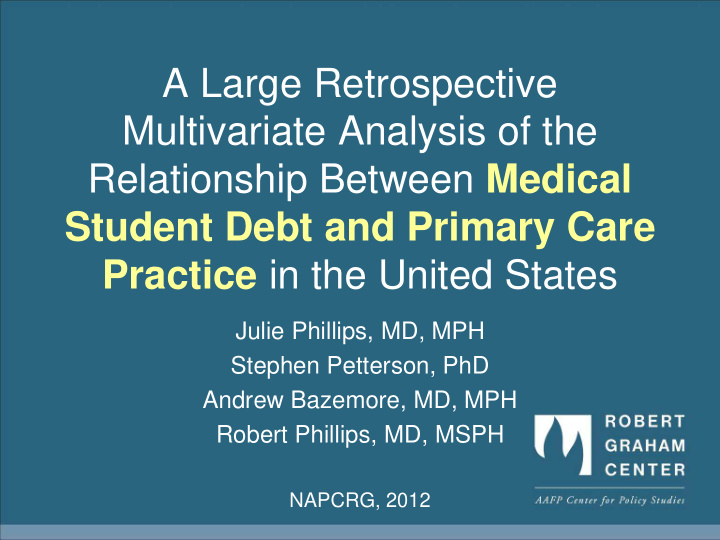



A Large Retrospective Multivariate Analysis of the Relationship Between Medical Student Debt and Primary Care Practice in the United States Julie Phillips, MD, MPH Stephen Petterson, PhD Andrew Bazemore, MD, MPH Robert Phillips, MD, MSPH NAPCRG, 2012
Mean Educational Debt of Indebted U.S. Medical Students, 1996 - 2012 86% of medical students borrowed money for medical school in 2012 (a record high) Source: AAMC, Graduation Questionnairre, 1996-2011
So What? • No clear linear relationship between debt level and primary care and specialty choice in several good studies • Some studies have shown that primary care physicians graduate with more debt, especially at low levels of debt • Does debt really impact the primary care workforce?
Limitations of Previous Studies • Medical student socioeconomic status correlates with debt and with primary care specialty choice – Students from low income families are more likely to choose primary care – Students from low income families have more debt • In many studies socioeconomic status has not been controlled
Limitations of Previous Studies Some studies have found non-linear relationships (Rosenblatt, 2005)
Purpose: Re-examine the relationship between debt and primary care specialty choice, using: - large sample size - control for student socioeconomic status - non-linear analysis
Methodology • Retrospective sample • All medical students who graduated from allopathic U.S. medical schools between 1988-2000, practicing medicine in the United States in 2010 • Excluded: – International medical graduates – Osteopathic physicians
Data Sources • AMA Physician Masterfile • AAMC Graduate Questionairre • National Health Service Corps participant database (HRSA) • Residency training data • Data sources were combined to create a unique analysis file. • Data de-identified before analysis. • IRB approval from Georgetown University. •Dataset used for previous analysis
Study Sample Characteristics • N = 136,232 • 60.2% male • 62.1% public medical school Median Debt $85,000
Control Variables • Demographic factors: – Rural birthplace (county) – Marital status (at med school graduation) – Age (at med school graduation) – Gender • National Health Service Corps participation • Medical school characteristics – Rural – Community based • Graduation year • All dollar amounts adjusted to 2010 dollars
Loans Used as Proxy Indicators of Medical Student Socioeconomic Status, 1988-2000 Loan Eligibility Loans for Students must demonstrate exceptional Disadvantaged financial need or be from a Students disadvantaged background. Institutions are mandated to give Perkins Loans “priority to the neediest students.” Must demonstrate financial Health Professions need, including parents’ Student Loan resources. 11
Outcomes • Family Medicine practice in 2010 • Primary care practice in 2010 – General practitioners – Family physicians – General pediatricians – General internists – Geriatricians
Percent of 1988-2000 Allopathic U.S. Medical Graduates in Family Medicine (univariate analysis) 20 Health Professions 18 Student Loans Percent 16 Perkins or Disadvantaged 14 Non-Income Based 12 $1-50K $50-100K $100-150K $150-200K >$200K Adjusted Mean Medical School Debt
Odds of Primary Care or Family Medicine Practice (all students, multivariate analysis)
Odds of Family Medicine Practice by Loan Type (multivariate analysis)
Socioeconomic Status Effect lower Cumulative effect: SES more likely to choose No clear linear medical primary care relationship between student debt and primary care Positive relationship fewer between debt and less financial primary care at low debt likely to resources more levels ( socioeconomic choose debt status effect stronger) primary care Negative relationship Deterrent Effect between debt and primary care at high debt levels ( deterrent effect stronger) 16
Socioeconomic Status Effect Likelihood Deterrent Effect of Choosing Cumulative Primary Care effect (not a direct summation) Educational Debt Level 17
Medical Student Debt is Eroding the Primary Care Workforce… especially Family Medicine 18
Acknowledgements and Disclosures • Josiah Macy, Jr. Foundation provided financial support for data collection and creation of the dataset • The information and opinions presented here do not necessarily reflect the views or policy of the American Academy of Family Physicians • We are grateful to the American Association of Medical Colleges for the use of their data, but the findings and conclusions do not reflect their views or policy.
Questions?
Study Sample Characteristics
6 Multivariate Models for Each Outcome: • All students* • Public school grads* • Private school grads* • Each loan grouping – Perkins Loans or Loans for Disadvantaged Students – Health Professions Student Loans – No income-based loans *Loan Types used as control variables in these models
Recommend
More recommend